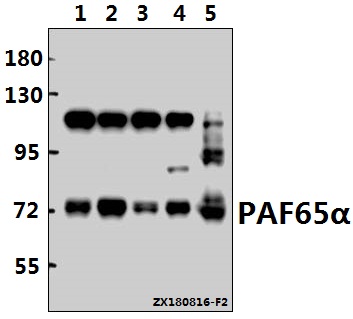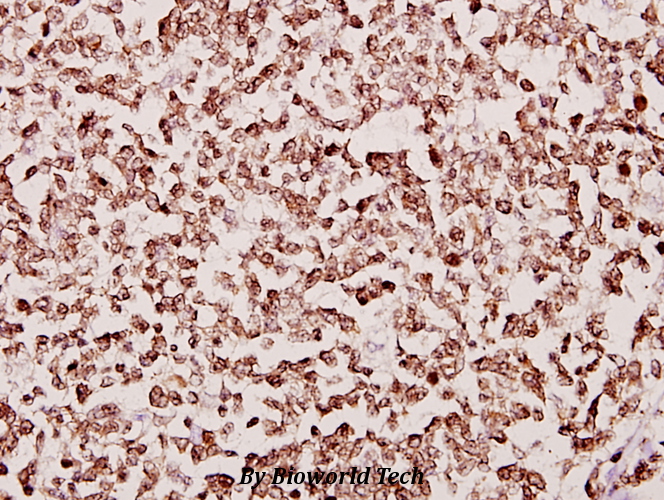Product Name :
PAF65α (Q53) polyclonal antibody Background :
In eukaryotic systems, the process of initiating transcription from protein-coding genes requires the presence of RNA polymerase II and a broad family of auxiliary transcription factors. TFIID is a general transcription factor that initiates preinitiation complex assembly through direct interaction with the TATA promoter element. Functioning as a multisubunit complex consisting of a small TATA-binding polypeptide and other TBP-associated factors (TAFs), TFIID mediates promoter responses to various transcriptional activators and repressors. TAF6L, also known as PAF65A, is a 622 amino acid nuclear protein that functions as part of the PCAF (p300/CBP-associated factor) histone acetylase complex. Product :
Rabbit IgG, 1mg/ml in PBS with 0.02% sodium azide, 50% glycerol, pH7.2 Storage&Stability :
Store at 4°C short term. Aliquot and store at -20°C long term. Avoid freeze-thaw cycles. Specificity :
PAF65α (Q53) polyclonal antibody detects endogenous levels of PAF65α protein. Immunogen :
Synthetic peptide, corresponding to amino acids 20-70 of Human PAF65α. Conjugate :
Unconjugated Modification :
Unmodification
PAF65α (Q53) polyclonal antibody Background :
In eukaryotic systems, the process of initiating transcription from protein-coding genes requires the presence of RNA polymerase II and a broad family of auxiliary transcription factors. TFIID is a general transcription factor that initiates preinitiation complex assembly through direct interaction with the TATA promoter element. Functioning as a multisubunit complex consisting of a small TATA-binding polypeptide and other TBP-associated factors (TAFs), TFIID mediates promoter responses to various transcriptional activators and repressors. TAF6L, also known as PAF65A, is a 622 amino acid nuclear protein that functions as part of the PCAF (p300/CBP-associated factor) histone acetylase complex. Product :
Rabbit IgG, 1mg/ml in PBS with 0.02% sodium azide, 50% glycerol, pH7.2 Storage&Stability :
Store at 4°C short term. Aliquot and store at -20°C long term. Avoid freeze-thaw cycles. Specificity :
PAF65α (Q53) polyclonal antibody detects endogenous levels of PAF65α protein. Immunogen :
Synthetic peptide, corresponding to amino acids 20-70 of Human PAF65α. Conjugate :
Unconjugated Modification :
Unmodification
-
 Western blot (WB) analysis of PAF65α (Q53) Antibody at 1:1000 dilution Lane1:HepG2 whole cell lysate(10ug) Lane2:HEK293T whole cell lysate(10ug) Lane3:A549 whole cell lysate(10ug) Lane4:EC9706 whole cell lysate(10ug) Lane5:The Lung tissue lysate of Mouse(40ug)
Western blot (WB) analysis of PAF65α (Q53) Antibody at 1:1000 dilution Lane1:HepG2 whole cell lysate(10ug) Lane2:HEK293T whole cell lysate(10ug) Lane3:A549 whole cell lysate(10ug) Lane4:EC9706 whole cell lysate(10ug) Lane5:The Lung tissue lysate of Mouse(40ug) -
 Immunohistochemistry (IHC) analyzes of PAF65α (Q53) pAb in paraffin-embedded human tonsil cancer tissue at 1:50.
Immunohistochemistry (IHC) analyzes of PAF65α (Q53) pAb in paraffin-embedded human tonsil cancer tissue at 1:50.
Bioworld Biotech only provide peptides for our antibodies and do not provide additional peptide customization services.
Price/Size :
USD 368/1mg/vial
Tips:
For phospho antibody, we provide phospho peptide(0.5mg) and non-phospho peptide(0.5mg).Describe :
Blocking peptides are peptides that bind specifically to the target antibody and block antibody binding. These peptide usually contains the epitope recognized by the antibody. Antibodies bound to the blocking peptide no longer bind to the epitope on the target protein. This mechanism is useful when non-specific binding is an issue, for example, in Western blotting (WB) and Immunohistochemistry (IHC). By comparing the staining from the blocked antibody versus the antibody alone, one can see which staining is specific; Specific binding will be absent from the western blot or IHC performed with the neutralized antibody.Formula:
Synthetic peptide was lyophilized with 100% acetonitrile and is supplied as a powder. Reconstitute with 0.1 ml DI water for a final concentration of 10 mg/ml.The purity is >90%,tested by HPLC and MS.
Storage:
The freeze-dried powder is more stable. For short time at 2-8°C. For long term storage store at -20°C.
Note :
This product is for research use only (RUO only). Not for use in diagnostic or therapeutic procedures.
 PAF65α (Q53) polyclonal antibody
PAF65α (Q53) polyclonal antibody  Datasheet
Datasheet COA
COA MSDS
MSDS SHIP
SHIP